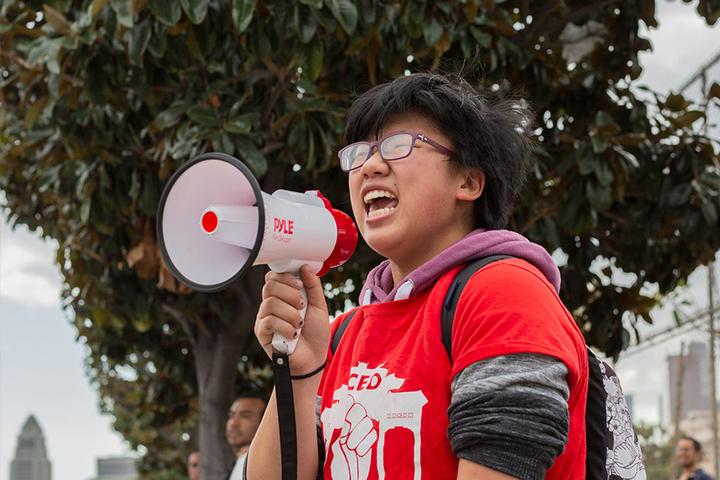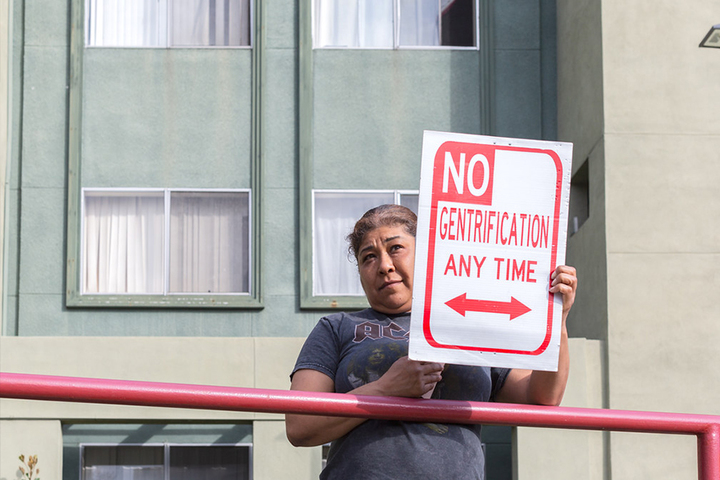You can’t do politics alone.
1. First of all, there is no housing crisis.
2. Housing is not in crisis.
3. Housing needs no trauma counselors.
4. Housing needs no lawyers. Housing needs no comrades or friends. Housing needs no representatives. Housing needs no organizers.
5. When we call this crisis a housing crisis, it benefits the people who design housing, who build housing, who profit from housing, not the people who live in it.
6. It encourages us to think in abstractions, in numbers, in interchangeable “units,” and not about people, or about power.
7. We don’t have a housing crisis. We have a tenants’ rights crisis.
8. In the LA Tenants Union, the subject of our work is not housing. It’s the tenant.
9. A tenant can be harassed, evicted, displaced, broke, undocumented, fed up, or organized. A tenant can be in kindergarten, can be a teacher, or a teacher on strike.
10. A tenant can be incarcerated or houseless.
11. In LATU we define a tenant as more than a renter. A tenant is anyone who doesn’t control their own housing.
12. In LATU, we frame our work around humans, not housing.
13. Humans, unlike housing, have race, gender, families, history.
14. Humans, unlike housing, have power.
15. We started LATU in 2015, with a single meeting in Hollywood.
16. We have since expanded to ten local chapters, which meet twice a month across the city, and have now organized dozens of tenants’ associations, some with hundreds of members.
17. LATU is a member-funded union. We are not a non-profit. We receive no funding except from dues, which average five dollars a month.
18. We are an all-volunteer effort.
19. This is how we got started:
20. In 2012, School of Echoes, a group of people, diverse in age, race, and organizing experience, figured out that what we all had in common was living in neighborhoods undergoing a process often euphemized as “change.”
21. The abstraction of this process allowed some to call it natural, inevitable, and even: good.
22. I’m talking about gentrification, whose definition in 2012 seemed to be written by the people it benefited.
23. Together, School of Echoes wanted to redefine gentrification not as a natural process, but as—to use Ursula K. Le Guinn’s phrase—a “human power,” produced by humans, by actors, agents, and targets.

24. So, we spent a few years listening: to STAY in Echo Park, where a gang injunction meant youth of color could be jailed just for sitting together outside;
25. to residents of Frogtown, where a new public park arrived right after half of neighborhood properties had changed hands in three years;
26. to Needle Exchange in Hollywood, whose outreach operations had to keep up with stepped up encampment sweeps;
27. to Union de Vecinos, who fought against Clinton’s Hope VI, which meant the demolition of more than nine hundred public apartments from Boyle Heights.
28. We heard: city governments expanding their tax bases not their services, nonprofits negotiating the terms of defeat, lawyers offering individualistic advice, and tenants who didn’t know their rights and thought there was nothing they could do.
29. We came to understand gentrification as purposeful and produced. We defined gentrification as “displacement and replacement of the poor for profit.”
30. But we didn’t just want to analyze gentrification, we wanted to stop it.
31. We recognized that the solidarity amongst gentrification’s beneficiaries—the police, landlords, developers, government representatives of the real estate state—meant we needed to build equal solidarity for ourselves.
32. In other words, we knew we couldn’t fight gentrification alone.
33. Focusing our work on tenants rather than housing, becoming tenant organizers not housing activists, has fundamentally shaped our participants, our strategies, and our goals.
34. We asked: In a city where more than half of Los Angeles speaks a language other than English at home, how will we build solidarity across language differences?
35. We asked: Gentrification most impacts the most vulnerable in our city, so how do we make the most vulnerable the most powerful in our movement?
36. We asked: How do we respect tenants by treating them as experts on their own experiences?
37. We asked: How will we make the LA Tenants Union a place where you learn you are not alone?
38. Here are some answers we came up with:
39. LATU operates under the principle of language justice, by which we mean everyone has the right to speak and be understood in the language they are most comfortable with.
40. The language justice committee performs simultaneous interpretation at each of our meetings—interpretation of Spanish for English speakers and interpretation of English for Spanish speakers—meaning our space attempts to privilege bilingual speakers, and no one language over another.
41. LATU is a horizontal movement: we build up from tenants’ associations in buildings, to local chapters in neighborhoods, to our union which spans the city.
42. But we want our members and our leadership to reflect the people most impacted by the tenants’ rights crisis. Which means horizontality can’t just be flat. In other words, horizontality can’t be color-blind, gender-blind, or difference-blind.
43. In LATU, tenants talk, strategize, and deal with individual crises—an eviction notice, a leaking roof, a deportation threat, a landlord with a pickax—but also learn how those individual crises are part of, caused by, and contribute to, a collective one.
44. We teach each other the rights we have to defend our homes—rent control, the warranty of habitability—but also our rights to organize and protest.
45. We practice and build solidarity across language, geography, and individual buildings. 46. LATU is not a service organization; it is a movement.
47. The movement’s role is not to solve the housing crisis, it’s to win tenants more rights, to build so much power amongst tenants that we make demands not requests.
48. Only tenants will win tenants the right, as urban scholar Chester Hartman put it, to stay put.
49. When we reenvision the housing crisis as a tenants’ rights crisis, we understand why the crisis seems to be permanent, a feature not a bug since the 1920s, and why what we call solutions—affordability covenants that expire, subsidies like Section 8 that no landlord will accept—seem only to fail.
50. When you call this crisis a housing crisis, you misunderstand the problem as one of production—the so-called “shortage”—and not of distribution. There are two vacant investor-owned homes for every houseless person in the country; cities overbuild luxury housing to appease investors, and the rents for working people do not decline despite that glut.

51. But you have heard it a million times and will hear it a million more: there is a housing crisis, and we will build our way out of it.
52. From Gavin Newsom’s “Marshall Plan” to Ben Carson’s embrace of deregulation, this supply-side, build-baby-build strategy follows what gets promoted as economic common sense.
53. But we understand supply-side policy as an attempt to govern housing without governance, to get people out of politics. To benefit the people who profit from housing, not the people who live in it.
54. We should hear in supply-side policy the echoes of “blight” designations and “slum clearance” projects, through which a focus on buildings rather than people allowed for their mass displacement.
55. There is no a shortage of housing except for poor and working people, which the market has never and will never provide.
56. As public housing advocate Catherine Bauer said in 1935: the situation is permanent.
57. As with housing crisis, here too we need to reconceptualize: Landlords don’t provide housing, they extract rent from housing. Developers don’t provide housing, they speculate on housing.
58. YIMBYs are not housing activists, but real-estate-development activists.
59. Remember: Housing justice is a struggle not a debate. As in any battle, there are sides.
60. Rather than ask why there aren’t enough affordable houses, we should ask why any home gets to be unaffordable.
61. The pre-condition for tenant justice is public control over the cost of private housing. Tenant justice is public control over all housing.
62. But how will we get this control?
63. It will not be given to us by the people who build, flip, and bet on housing, or who use it like a bank.
64. It will not be given to us by our representatives, with their penchant for kickbacks.
65. It will not be bestowed on us by Zuckerberg’s charity.
66. Control over the cost of housing will not come from nonprofit “Affordable Housing” development or Section 8 subsidies.
67. Remember: “Affordable” is still the opposite of public.
68. When CA governor Gavin Newsom calls his plan for housing incentives a “Marshall Plan,” we shouldn’t ignore the Cold War–era anticommunism within the metaphor.
69. Because from the perspective of tenants’ rights, we don’t just need to control the market, we need to kick it the fuck out of our lives.
70. We need to stop looking to landlords, developers, planners, and economists to solve a problem whose insolubility protects their interests.
71. Instead, we need to look to each other, to respect the expertise gained through struggle. In LATU, the solution looks like:
72. The Exposition Tenants Association from South LA brought their protest to the mansion of their evictor, pointing out there would be enough room for all of them inside.
73. Standing at his door, we remember eviction is personal. When we mobilize, we don’t shy away from making the fight against eviction personal too.
74. As with the transfer of wealth from South LA to Orange County, one neighborhood’s wealth isn’t an accident, but predicated on the subjugation and exploitation of another.
75. Rent is the mortgage on a landlord’s second house, is the guarantor of generational assets, is the corporate income stream, is rolled into a financialized security and offered up to hedge funds as a bond.

76. The Hillside Villa Tenants Association focused citywide attention on the expiration of “Affordable Housing” covenants. “Affordable Housing,” the city, state, and county’s preferred policy solution to the crisis, uses incentives or subsidies as a trade-off for rent limits, which have an expiration date. Across LA, their expiration now threatens to displace thousands of residents.
77. Calling for the eminent domain of their building subsized with zero interest loans, Hillside Villa’s regular actions exposed the scam of public investment for private gain and the lie of affordability itself.
78. The East Second Street Tenants Association in Boyle Heights, determined to meet weekly and act together, continued a rent strike for almost twelve months, inspired campouts at their landlord’s house, received more national press than we can count, and eventually won LATU’s first collective-bargaining agreement, which controls rent increases and secures the right to renegotiate.
79. As a tactic, rent strikes demonstrate the underlying force of our union: Even when we have no laws to protect us as tenants, we still have each other.
80. Though they are not supported by City Council members, though they’re discouraged by the Housing Department and limited by court decisions, rent strikes sometimes get the goods.
81. There’s more:
82. The Burlington Unidos Tenants Association, the largest rent strike in LA history.
83. #FuckYourFlips: a viral media campaign that encouraged interventions in the local processes of flipping and predation—tearing down those “cash for your houses” signs.
84. Monthly general meetings, our education spaces, which have held focused workshops on new techniques of evictions such as Tenants In Common; on the role of policing and ICE in gentrification; on strategies for legal and extralegal direct action.
85. We refuse to see our homes as quantifiable or interchangeable abstractions. We recognize them as interlocking sites of oppression and exploitation, but also of trust, community, and power.
86. We are tenants’ rights organizers not housing activists.
87. In other words, we care more about people than the housing they live in.
88. I’d like you to consider how close we are to winning, to housing as a right. To the basic need of shelter met for all.
89. What things would have to change for us to get there? Perhaps more importantly, where will this work take place? What will the room look like? Who will get a chance to speak? What kind of food will they serve?
90. I’m biased, I know, but I think that place is the LA Tenants Union.
91. Right now, we are working on growing. We want a local chapter for every neighborhood council, to take back the energy wasted in political participation without power.
92. We are working on balancing long-term thinking and strategy with the urgency of impeding evictions.
93. We are working on keeping people involved no matter how their cases are resolved, working to distribute power through associations, locals, committees, and the union.
94. We have initiated a monthly call between autonomous tenants’ unions across the country, establishing the ATUN network to share analysis, tactics, and strategy.
95. We are beginning a practice of occupations to greet the sheriffs when they arrive.
96. We are organizing multiple buildings owned by the same landlord.
97. And we are planning the baby steps before a general rent strike.
98. I invite everyone to join us. If you’re not in LA, another autonomous tenant union will do.
99. Defeat is not inevitable.
100. We make the community by defending it.
101. You cannot, under any circumstances, do politics alone.





